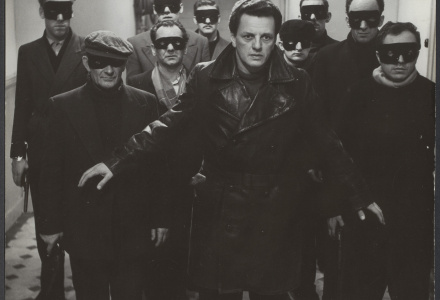WWII and the Resistance: From LO-LKP to De overval
After WWII, Dutch film was in a state of devastation – a Stunde Null. The studios in Duivendrecht and Wassenaar had been plundered and destroyed. Many people essential to the film industry and the cinema business had either been killed or had left the Netherlands to seek refuge elsewhere. Everything needed to be started over again from scratch.
The first to do so were a number of documentary filmmakers who united to form the Nederlandse Werkgemeenschap voor Filmproductie. Veterans such as Mannus Franken, Paul Schuitema, Jo de Haas and Jan Hin made several short documentaries with newcomers such as Herman van der Horst about the ravaged Netherlands. This would be the prelude to a rich documentary tradition in Dutch film that would reach its high point in the 1950s with filmmakers such as the above-mentioned Van der Horst as well as Bert Haanstra, Ytzen Brusse and Louis van Gasteren. These men won numerous international awards, and the Dutch documentary was soon renowned far beyond the borders of the Netherlands.
Documenting the Occupation
Developments in the area of fiction film were less dynamic, however. In contrast to the documentary makers’ situation, the making of fiction films was impacted more heavily by the loss of production infrastructures. Financial problems also an important issue. The first fiction films that were made were dramatised documentaries (mainly short films) about the occupation and the resistance. After making the documentary Friesland (1945), Hein Josephson was commissioned by the Stichting Nederlandse Studenthulp (Foundation Dutch Student Aid) to make Zes jaren and Op drift, a film about family reunification. In that same year, these films were followed by Samen op weg by Otto van Neijenhoff and Bezet gebied by Frans Dupont. These were films that stayed close to the reality of the war and showed how the Dutch had tried to survive and resist the enemy; problematic issues were handled only sketchily. In general, filmmakers stuck to clear-cut oppositions: good or bad, collaboration or resistance.
The first major resistance films, LO-LKP (Landelijke Onderduikers-Landelijke Knokploegen) by Max de Haas and Niet tevergeefs by French director Edmond T. Gréville, were released in 1948-1949. Like its short predecessors, LO-LKP was set up as a documentary, but De Haas was able to fit in the fictional scenes in a believable way, despite the fact that most of his main characters were played by untrained actors. The production of Niet tevergeefs was able to take place in the newly renovated Cinetone Studio’s. The Nederlandse Bioscoopbond had made a million guilders available for its renovation. The film, a Dutch-English co-production, was released in two language versions, Dutch and English. Niet tevergeefs was unsuccessful in contrast with LO-LKP, which drew more than 350.000 viewers; while this was a respectable turnout, it pales in comparison with the first Dutch post-war comedy, Een koninkrijk voor een huis!.
More than 1.3 million viewers saw this film, which addressed the housing shortage that occurred after WWII in a humorous way. The war and its aftermath were backdrops in the film. Een koninkrijk voor een huis! was primarily old-fashioned entertainment like films had been before the war.
Waiting for De overval
Een koninkrijk voor een huis! was a preview of what was to come for Dutch filmgoers in the 1950s. There was one film, De dijk is dicht released in 1950, that portrayed the issues of the war in a direct way, but the rest of the films of that time were mainly light entertainment. As producer Rudi Meyer put it: 'die Menschen willen nu ja toch geen oorlog meer!' (‘People just don’t want any more war now!’).
It was only when interest in WWII was revived, thanks to the work of historian Lou de Jong, that the war would return as a theme in Dutch feature films. The first of these was De overval (1962), a documentary-like reconstruction of a number of prisoners from a prison in Leeuwarden. With nearly 1.5 million viewers, De overval was the box-office hit of the 1960s and was the start of a renewed interest in Dutch films that had been made before WWII.
more information
If you are looking for more material from our collection, please contact Film Sales:
sales@eyefilm.nl
phone +31 (0)20 5891 426

